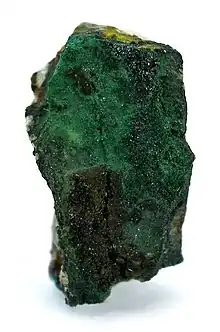| Aerugite | |
|---|---|
 | |
| General | |
| Category | Arsenate minerals |
| Formula (repeating unit) | Ni9(AsO4)2AsO6 |
| IMA symbol | Aru[1] |
| Strunz classification | 8.BC.15 |
| Crystal system | Trigonal |
| Crystal class | Hexagonal scalenohedral (3m) H-M symbol: (3 2/m) |
| Space group | R3m |
| Identification | |
| Color | Grass green, blue-green |
| Crystal habit | Massive to crystalline crusts |
| Mohs scale hardness | 4 |
| Luster | Adamantine |
| Streak | light green, greenish white |
| Diaphaneity | Opaque to semitransparent |
| Specific gravity | 5.85–5.95 |
| References | [2][3][4] |
Aerugite is a rare complex nickel arsenate mineral with a variably reported formula: Ni9(AsO4)2AsO6. It forms green to deep blue-green trigonal crystals. It has a Mohs hardness of 4 and a specific gravity of 5.85 to 5.95.
It was first described in 1858 in either the South Terres mine of Cornwall, England or in the Ore Mountains, Saxony, Germany. The origin is disputed. The most common occurrence is as an incrustation on furnace walls in which ores are roasted. Its name comes from the Latin word aerugo for copper rust.
See also
References
- ↑ Warr, L.N. (2021). "IMA–CNMNC approved mineral symbols". Mineralogical Magazine. 85 (3): 291–320. Bibcode:2021MinM...85..291W. doi:10.1180/mgm.2021.43. S2CID 235729616.
- ↑ Mindat.org Aerugite page
- ↑ Webmineral Aerugite page
- ↑ http://rruff.geo.arizona.edu/doclib/hom/aerugite.pdf Handbook of Mineralogy
This article is issued from Wikipedia. The text is licensed under Creative Commons - Attribution - Sharealike. Additional terms may apply for the media files.